Development of an Oxy-Fuel Combustion System in a Compression-Ignition Engine for Ultra-Low Emissions Powerplants Using CFD and Evolutionary Algorithms
Abstract
:1. Introduction
- A computational engine model that reproduces a full load engine operating condition was developed and the model was validated. This model is then evaluated in oxy-fuel combustion operating mode, providing suitable thermodynamic conditions in the exhaust line.
- A novel methodology that combines the CFD code with the Particle Swarm Optimization (PSO) algorithm was used to perform the optimization study in a reasonable period of time, thanks to the integration of tools for fast and accurate data post-processing.
- The study involves the analysis of several inputs (combustion chamber design and engine settings variables) to obtain the best set of parameters that reduces the soot emissions and maximizes the efficiency, considering the constraints of the CO emissions and the maximum pressure () of the engine.
2. Methodology
- Initially, a CFD model was created and validated against experimental data from a CI engine with conventional fuel and air.
- The second step is the implementation of the oxy-fuel combustion boundary conditions for the point of maximum power defined in a previous study of Serrano et al. [22].
- Based on this study, it was observed the possibility to optimize the combustion system of the engine to improve the combustion process of this engine.
- With this possibility an optimization process was carried out focusing in the combustion system by using CFD simulation coupled with an optimization algorithm in order to reduce soot emissions and improve efficiency.
2.1. Engine Configuration
2.2. CFD Model Description and Model Validation
2.2.1. Oxy-Fuel Combustion Model
2.3. Computational Optimization Details
Optimization Methodology
2.4. Optimization Parameters and Objective Function
2.4.1. Piston Bowl Geometry Generator
2.4.2. Mesh Generator
2.4.3. Virtual Injection Model
3. Results and Discussion
3.1. Optimization Process Results
3.2. Engine Results
4. Conclusions
- The CFD-NS coupling optimization method has demonstrated to be an adequate procedure for redefining the baseline combustion system of a CI engine when it is operated under oxy-fuel combustion concept. This method includes several routines to automatize the optimization process.
- The new combustion system changes the baseline geometry to a bathtub shape that improves the engine efficiency and reduces the heat transfer losses. The number of injector nozzles changes from 10 to 7, allowing an improved interaction between the fuel and the oxygen inside the combustion chamber. The injection pressure is higher than the baseline, which leads a better fuel atomization and evaporation. The spray angle is higher and is better adjusted with the piston bowl geometry. With this new configuration, the swirl number should be lower in order to avoid the interaction between the sprays. Lastly, the SOI must be adjusted to control the maximum in-cylinder pressure limit.
- The optimized combustion system for oxy-fuel combustion improves the efficiency levels obtained by the baseline configuration (from 26.6% to 35.7%) while reducing soot emissions from 11.37 mg/s to a virtual zero. Soot avoidance is very important for this engine concept because exhaust gas energy must be recovered in proper regenerators (heat exchangers) to increase air temperature and separate O from N in the MIEC. Therefore, soot must be minimized in the combustion chamber to prevent heat exchangers from clogging.
- Similarly, the new combustion system is able to reduce CO emissions up to similar levels of conventional diesel combustion. In addition, CH are below the conventional diesel combustion with air because there is no tradeoff between hydrocarbon oxidation and NO reduction. This is a big advantage of oxy-fuel combustion because it allows for the minimization of pollutant emissions from the origin in the combustion chamber, because all design objective points are in the same direction of maximizing hydrocarbon oxidation. Having a virtual zero harmful emissions engine outside the combustion chamber makes the objective of obtaining a very high purity CO easier. If some oxidation catalyst were needed for exhaust gases, after-treatment would be easier to design as well, due to the high temperatures, and lack of NO and oxygen excess. However, the efficiency levels are significantly lower (35.7% against 40.1%), compromising the fuel consumption. Nevertheless, the possibility of CO capture by simply condensing the water vapor allows for the decoupling of the BSFC increment from CO emissions. Future works will be in the direction of minimizing BSFC while keeping the virtual zero emissions achievement.
Author Contributions
Funding
Institutional Review Board Statement
Informed Consent Statement
Data Availability Statement
Acknowledgments
Conflicts of Interest
Abbreviations
| Letters | |
| c1 | Individual Weight |
| c2 | Social Weight |
| coef | CO Coefficient |
| coef | Efficiency Coefficient |
| coefpmax | Maximum Pressure Coefficient |
| coef | Soot Coefficient |
| MC(t) | Centre of Mass |
| Current Best Position | |
| pmax | Maximum pressure (bar) |
| (t) | Repository |
| Velocityi | |
| Positioni | |
| Boundary of the search space | |
| Boundary of the search space | |
| w | Inertia Weight |
| Greek symbols | |
| Random Vector | |
| Random Vector | |
| Random Vector | |
| Random Vector | |
| Random Vector | |
| Random Vector | |
| Acronyms | |
| CAS | Cryogenic Air Separation |
| CFD | Computational Fluid Dynamics |
| CI | Compression-ignited |
| CR | Compression Ration |
| EGR | Exhaust Gas Re-circulation |
| EVO | Exhaust Valve Opening |
| GHG | Greenhouse Gases |
| GP | Geometrical Point |
| HR | Heat Release |
| ICE | Internal Combustion Engine |
| MIEC | Mixed Ionic-Electronic Conducting Membranes |
| ISFC | Specific Fuel Consumption |
| IVC | Intake Valve Closing |
| KH | Kelvin-Helmholtz |
| mRIF | Multi Representative Interactive Flamelet |
| NS | Novelty Search |
| PSO | Particle Swarm Optimization |
| RANS | Reynolds-Averaged Navier Stokes |
| RoHR | Rate of Heat Release |
| ROI | Rate of Injection |
| RT | Ryleigh-Taylor |
| SOI | Start of Injection |
| TDC | Top Dead Center |
| VEMOD | Virtual Engine Model |
References
- Intergovernmental Panel on Climate Change. Climate Change 2014. Mitigation of Climate Change: Working Group III Contribution to the IPCC Fifth Assessment Report; Cambridge University Press: Cambridge, UK; New York, NY, USA, 2014. [Google Scholar] [CrossRef] [Green Version]
- European Commission. COM15—Communication: A Policy Framework for Climate and Energy in the Period from 2020 to 2030. 2014. Available online: https://eur-lex.europa.eu/legal-content/EN/TXT/PDF/?uri=CELEX:52014DC0015&from=EN (accessed on 1 April 2022).
- Paltsev, S.; Morris, J.; Kheshgi, H.; Herzog, H. Hard-to-Abate Sectors: The role of industrial carbon capture and storage (CCS) in emission mitigation. Appl. Energy 2021, 300, 117322. [Google Scholar] [CrossRef]
- Wu, H.; Xu, M.; Li, Y.; Wu, J.; Shen, J.; Liao, H. Experimental research on the process of compression and purification of CO2 in oxy-fuel combustion. Appl. Energy 2020, 259, 114123. [Google Scholar] [CrossRef]
- Serrano, J.; Martin, J.; Gomez-Soriano, J.; Raggi, R. Theoretical and experimental evaluation of the spark-ignition premixed oxy-fuel combustion concept for future CO2 captive powerplants CO EU ST. Energy Convers. Manag. 2021, 244, 114498. [Google Scholar] [CrossRef]
- Mancini, N.D.; Mitsos, A. Conceptual design and analysis of ITM oxy-combustion power cycles. Phys. Chem. Chem. Phys. 2011, 13, 21351–21361. [Google Scholar] [CrossRef] [PubMed]
- Portillo, E.; Alonso-Fariñas, B.; Vega, F.; Cano, M.; Navarrete, B. Alternatives for oxygen-selective membrane systems and their integration into the oxy-fuel combustion process: A review. Sep. Purif. Technol. 2019, 229, 115708. [Google Scholar] [CrossRef]
- Baumann, S.; Serra, J.M.; Lobera, M.P.; Escolástico, S.; Schulze-Küppers, F.; Meulenberg, W.A. Ultrahigh oxygen permeation flux through supported Ba0.5Sr0.5Co0.8Fe0.2O3-δ membranes. J. Membr. Sci. 2011, 377, 198–205. [Google Scholar] [CrossRef] [Green Version]
- Catalán-Martínez, D.; Santafé-Moros, A.; Gozálvez-Zafrilla, J.M.; García-Fayos, J.; Serra, J.M. Characterization of oxygen transport phenomena on BSCF membranes assisted by fluid dynamic simulations including surface exchange. Chem. Eng. J. 2020, 387, 124069. [Google Scholar] [CrossRef]
- Kanniche, M.; Gros-Bonnivard, R.; Jaud, P.; Valle-Marcos, J.; Amann, J.M.; Bouallou, C. Pre-combustion, post-combustion and oxy-combustion in thermal power plant for CO2 capture. Appl. Therm. Eng. 2010, 30, 53–62. [Google Scholar] [CrossRef] [Green Version]
- Wimmer, K.; Sanz, W. Optimization and comparison of the two promising oxy-combustion cycles NET Power cycle and Graz Cycle. Int. J. Greenh. Gas Control 2020, 99, 103055. [Google Scholar] [CrossRef]
- Al-Sheikh, F.A.; Elkamel, A.; Anderson, W.A. Comparison between Post- and Oxy-Combustion Systems in a Petroleum Refinery Unit Using Modeling and Optimization. World Acad. Sci. Eng. Technol. Int. J. Chem. Mol. Nucl. Mater. Metall. Eng. 2017, 11, 793–799. [Google Scholar]
- Gerbelová, H.; Van Der Spek, M.; Schakel, W. Feasibility Assessment of CO2 Capture Retrofitted to an Existing Cement Plant: Post-combustion vs. Oxy-fuel Combustion Technology. Energy Procedia 2017, 114, 6141–6149. [Google Scholar] [CrossRef]
- Van Blarigan, A.; Kozarac, D.; Seiser, R.; Cattolica, R.; Chen, J.Y.; Dibble, R. Experimental Study of Methane Fuel Oxycombustion in a Spark-Ignited Engine. J. Energy Resour. Technol. 2014, 136, 012203. [Google Scholar] [CrossRef]
- Tan, Q.; Hu, Y. A study on the combustion and emission performance of diesel engines under different proportions of O2 & N2 & CO2. Appl. Therm. Eng. 2016, 108, 508–515. [Google Scholar] [CrossRef]
- Arnau, F.; García-Cuevas, L.; Novella, R.; Gutiérrez, F. Adapting an internal combustion engine to oxy-fuel combustion with in-situ oxygen production. In Proceedings of the ASME 2021 Internal Combustion Engine Division Fall Technical Conference, Virtual, Online, 13–15 October 2021. [Google Scholar]
- Serrano, J.; Arnau, F.; García-Cuevas, L.; Farias, V. Oxy-fuel combustion feasibility of compression ignition engines using oxygen separation membranes for enabling carbon dioxide capture. Energy Convers. Manag. 2021, 247, 114732. [Google Scholar] [CrossRef]
- Krieger, G.C.; Campos, A.P.; Takehara, M.D.; Alfaia Da Cunha, F.; Gurgel Veras, C.A. Numerical simulation of oxy-fuel combustion for gas turbine applications. Appl. Therm. Eng. 2015, 78, 471–481. [Google Scholar] [CrossRef]
- Nemitallah, M.A.; Habib, M.A. Numerical investigation of liquid methanol evaporation and oxy-combustion inside a button-cell ITM reactor. Appl. Therm. Eng. 2017, 112, 378–391. [Google Scholar] [CrossRef]
- Kang, Z.; Chen, S.; Wu, Z.; Deng, J.; Hu, Z.; Li, L. Simulation Study of Water Injection Strategy in Improving Cycle Efficiency Based on a Novel Compression Ignition Oxy-Fuel Combustion Engine. SAE Int. J. Engines 2018, 11, 935–945. [Google Scholar] [CrossRef]
- Mobasheri, R.; Aitouche, A.; Peng, Z.; Li, X. Influence of Oxy-Fuel Combustion on Engine Operating Conditions and Combustion Characteristics in a High Speed Direct Injection (HSDI) Diesel Engine under Homogenous Charge Compression Ignition (HCCI) Mode; SAE Technical Paper; SAE International: Warrendale, PA, USA, 2020; pp. 1–10. [Google Scholar] [CrossRef]
- Serrano, J.; Arnau, F.; Martín, J.; Novella, R.; García-Cuevas, L.; Bracho, G.; Goméz-Soriano, J. Oxy-Fuel Combustion Engine for Highly Efficient Onboard CO2 Capture. Another Step Forward in the Path to a CO2 Circular Economy. Sustainable Internal Combustion Engine Virtual Symposium 2021. Available online: https://www.sustainable-ic-enginevirtuallive.com/ (accessed on 10 February 2021).
- Martin, J.; Arnau, F.; Piqueras, P.; Auñon, A. Development of an Integrated Virtual Engine Model to Simulate New Standard Testing Cycles; SAE Technical Paper; SAE Internacional: Warrendale, PA, USA, 2018; pp. 1–17. [Google Scholar] [CrossRef] [Green Version]
- OpenFOAM Website. Available online: https://openfoam.org/ (accessed on 10 May 2022).
- Montenegro, G.; Onorati, A.; Piscaglia, F.; D’Errico, G. Integrated 1D-MultiD Fluid Dynamic Models for the Simulation of ICE Intake and Exhaust Systems; SAE Technical Paper; SAE International: Warrendale, PA, USA, 2007; Volume 1, pp. 776–790. [Google Scholar] [CrossRef] [Green Version]
- Lucchini, T.; D’Errico, G.; Jasak, H.; Tukovic, Z. Automatic Mesh Motion with Topological Changes for Engine Simulation; SAE Technical Paper; SAE International: Warrendale, PA, USA, 2007; Volume 1, pp. 1–20. [Google Scholar] [CrossRef]
- Ismail, H.; Ng, H.; Gan, S.; Lucchini, T. Approach for the Modeling of Reacting Biodiesel Fuel Spray Using OpenFOAM; SAE Technical Paper; SAE International: Warrendale, PA, USA, 2014; Volume 1, pp. 1–9. [Google Scholar] [CrossRef]
- D’Errico, G.; Lucchini, T.; Hardy, G.; Tap, F.; Ramaekers, G. Combustion Modeling in Heavy Duty Diesel Engines Using Detailed Chemistry and Turbulence-Chemistry Interaction; SAE Technical Paper; SAE International: Warrendale, PA, USA, 2015; Volume 1, pp. 1–14. [Google Scholar] [CrossRef]
- Ismail, H.M.; Ng, H.K.; Gan, S.; Lucchini, T.; Onorati, A. Development of a reduced biodiesel combustion kinetics mechanism for CFD modelling of a light-duty diesel engine. Fuel 2013, 106, 388–400. [Google Scholar] [CrossRef]
- Ismail, H.M.; Ng, H.K.; Cheng, X.; Gan, S.; Lucchini, T.; D’Errico, G. Development of Thermophysical and Transport Properties for the CFD Simulations of In-Cylinder Biodiesel Spray Combustion. Energy Fuels 2012, 26, 4857–4870. [Google Scholar] [CrossRef]
- Payri, R.; Gimeno, J.; Novella, R.; Bracho, G. On the rate of injection modeling applied to direct injection compression ignition engines. Int. J. Engine Res. 2016, 17, 1015–1030. [Google Scholar] [CrossRef] [Green Version]
- Yakhot, V.; Orszag, S.A. Renormalization group analysis of turbulence. I. Basic theory. J. Sci. Comput. 1986, 1, 3–51. [Google Scholar] [CrossRef]
- Angelberger, C.; Poinsot, T.; Delhay, B. Improving Near-Wall Combustion and Wall Heat Transfer Modeling in SI Engine Computations; SAE Technical Paper; SAE International: Warrendale, PA, USA, 1997. [Google Scholar] [CrossRef]
- Benajes, J.; Olmeda, P.; Martín, J.; Carreño, R. A new methodology for uncertainties characterization in combustion diagnosis and thermodynamic modelling. Appl. Therm. Eng. 2014, 71, 389–399. [Google Scholar] [CrossRef]
- Kang, Z.; Wu, Z.; Zhang, Z.; Deng, J.; Hu, Z.; Li, L. Study of the Combustion Characteristics of a HCCI Engine Coupled with Oxy-Fuel Combustion Mode. SAE Int. J. Engines 2017, 10, 908–916. [Google Scholar] [CrossRef]
- Kennedy, J.; Eberhart, R. 47-Particle Swarm Optimization Proceedings. In Proceedings of the ICNN’95—International Conference on Neural Networks, Perth, WA, Australia, 27 November–1 December 1995; Volume 11, pp. 111–117. [Google Scholar]
- Lehman, J.; Stanley, K.O. Exploiting open-endedness to solve problems through the search for novelty. In Artificial Life—ALIFE; MIT Press: Cambridge, MA, USA, 2008. [Google Scholar]
- Benajes, J.; Novella, R.; Pastor, J.M.; Hernández-López, A.; Hasegawa, M.; Tsuji, N.; Emi, M.; Uehara, I.; Martorell, J.; Alonso, M. Optimization of the combustion system of a medium duty direct injection diesel engine by combining CFD modeling with experimental validation. Energy Convers. Manag. 2016, 110, 212–229. [Google Scholar] [CrossRef]
- Payri, R.; Salvador, F.J.; Gimeno, J.; Bracho, G. A new methodology for correcting the signal cumulative phenomenon on injection rate measurements. Exp. Tech. 2008, 32, 46–49. [Google Scholar] [CrossRef]
- Zubel, M.; Ottenwälder, T.; Heuser, B.; Pischinger, S. Combustion system optimization for dimethyl ether using a genetic algorithm. Int. J. Engine Res. 2021, 22, 22–38. [Google Scholar] [CrossRef]
- Yoon, S.; Lee, S.; Kwon, H.; Lee, J.; Park, S. Effects of the swirl ratio and injector hole number on the combustion and emission characteristics of a light duty diesel engine. Appl. Therm. Eng. 2018, 142, 68–78. [Google Scholar] [CrossRef]
- Shi, Y.; Reitz, R.D. Assessment of optimization methodologies to study the effects of bowl geometry, spray targeting and swirl ratio for a heavy-duty diesel engine operated at High-Load. SAE Int. J. Engines 2009, 1, 537–557. [Google Scholar] [CrossRef]
- Han, S.; Bae, C. The influence of Fuel Injection Pressure and Intake Pressure on Conventional and Low Temperature Diesel Combustion; SAE Technical Paper; SAE International: Warrendale, PA, USA, 2012. [Google Scholar] [CrossRef]
- Agarwal, A.K.; Srivastava, D.K.; Dhar, A.; Maurya, R.K.; Shukla, P.C.; Singh, A.P. Effect of fuel injection timing and pressure on combustion, emissions and performance characteristics of a single cylinder diesel engine. Fuel 2013, 111, 374–383. [Google Scholar] [CrossRef]
- Yaliwal, V.S.; Banapurmath, N.R.; Gireesh, N.M.; Hosmath, R.S.; Donateo, T.; Tewari, P.G. Effect of nozzle and combustion chamber geometry on the performance of a diesel engine operated on dual fuel mode using renewable fuels. Renew. Energy 2016, 93, 483–501. [Google Scholar] [CrossRef]
- Dreisbach, R.; Graf, G.; Kreuzig, G.; Theissl, H.; Pfahl, U. HD Base Engine Development to Meet Future Emission and Power Density Challenges of a DDI™ Engine; SAE Technical Paper; SAE International: Warrendale, PA, USA, 2007. [Google Scholar] [CrossRef]
- Miles, P.C.; Andersson, Ö. A review of design considerations for light-duty diesel combustion systems. Int. J. Engine Res. 2016, 17, 6–15. [Google Scholar] [CrossRef]
- Benajes, J.; Pastor, J.V.; García, A.; Monsalve-Serrano, J. An experimental investigation on the influence of piston bowl geometry on RCCI performance and emissions in a heavy-duty engine. Energy Convers. Manag. 2015, 103, 1019–1030. [Google Scholar] [CrossRef]
- Cursente, V.; Pacaud, P.; Gatellier, B. Reduction of the compression ratio on a hsdi diesel engine: Combustion design evolution for compliance the future emission standards. SAE Int. J. Fuels Lubr. 2009, 1, 420–439. [Google Scholar] [CrossRef]
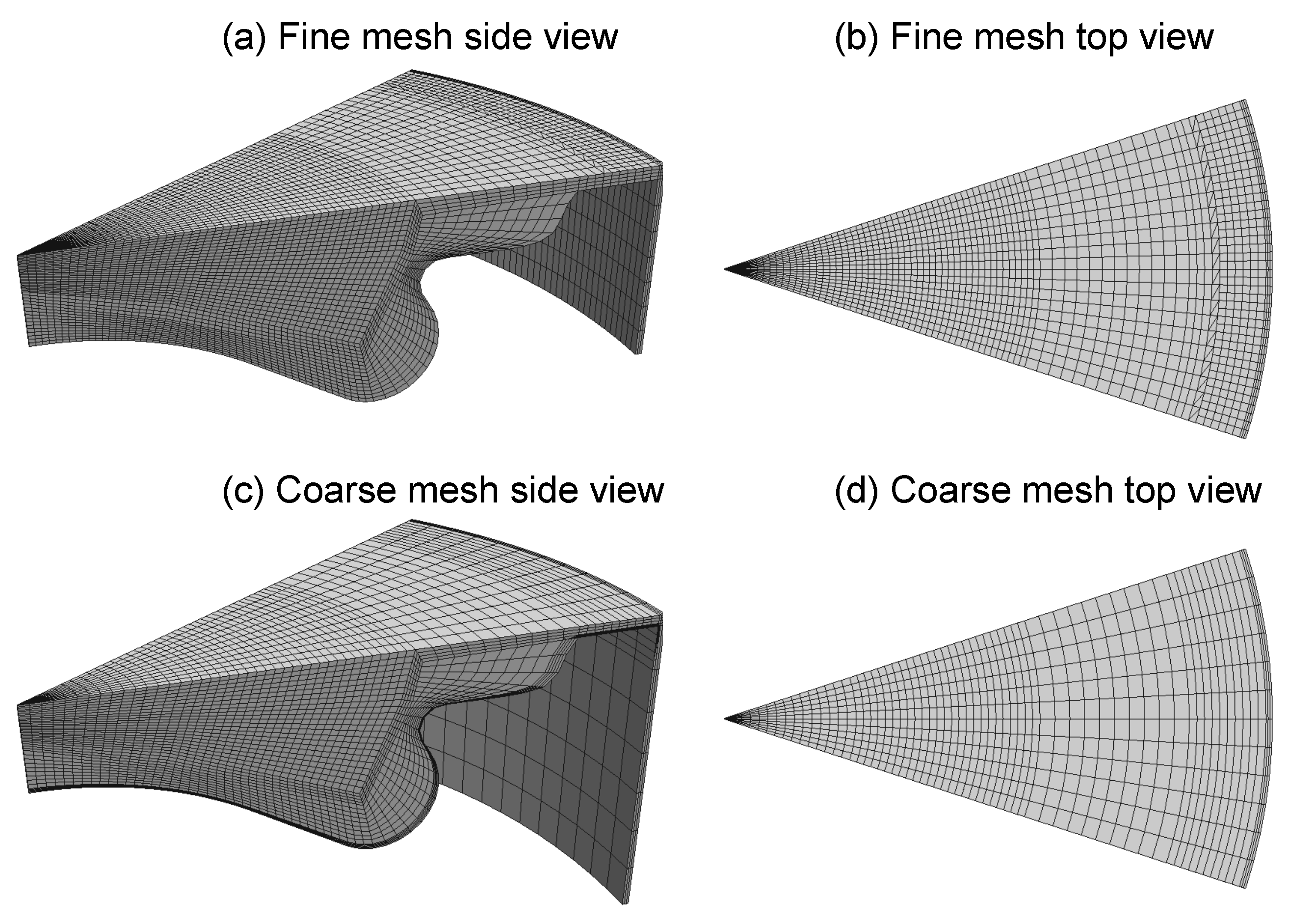
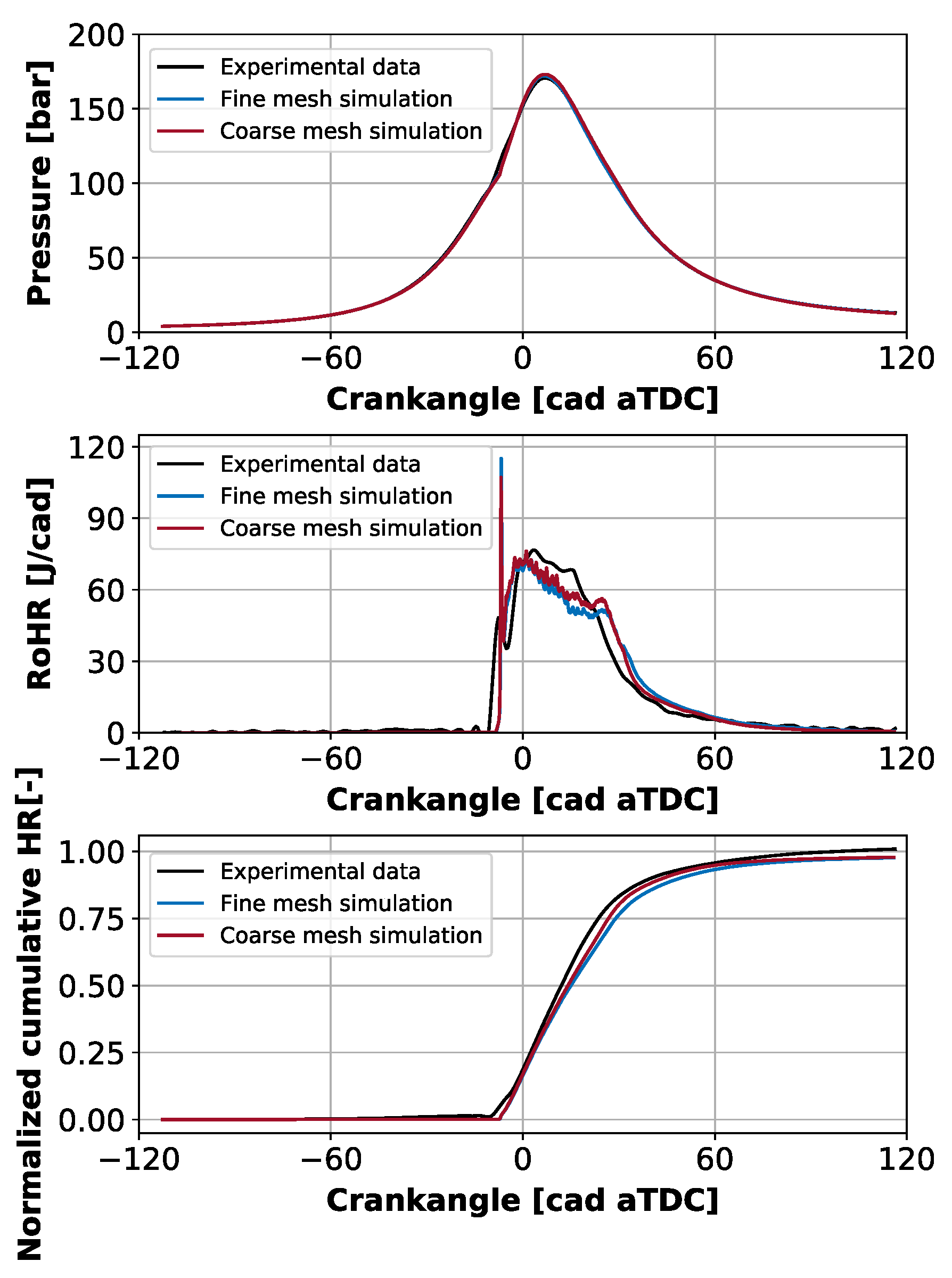
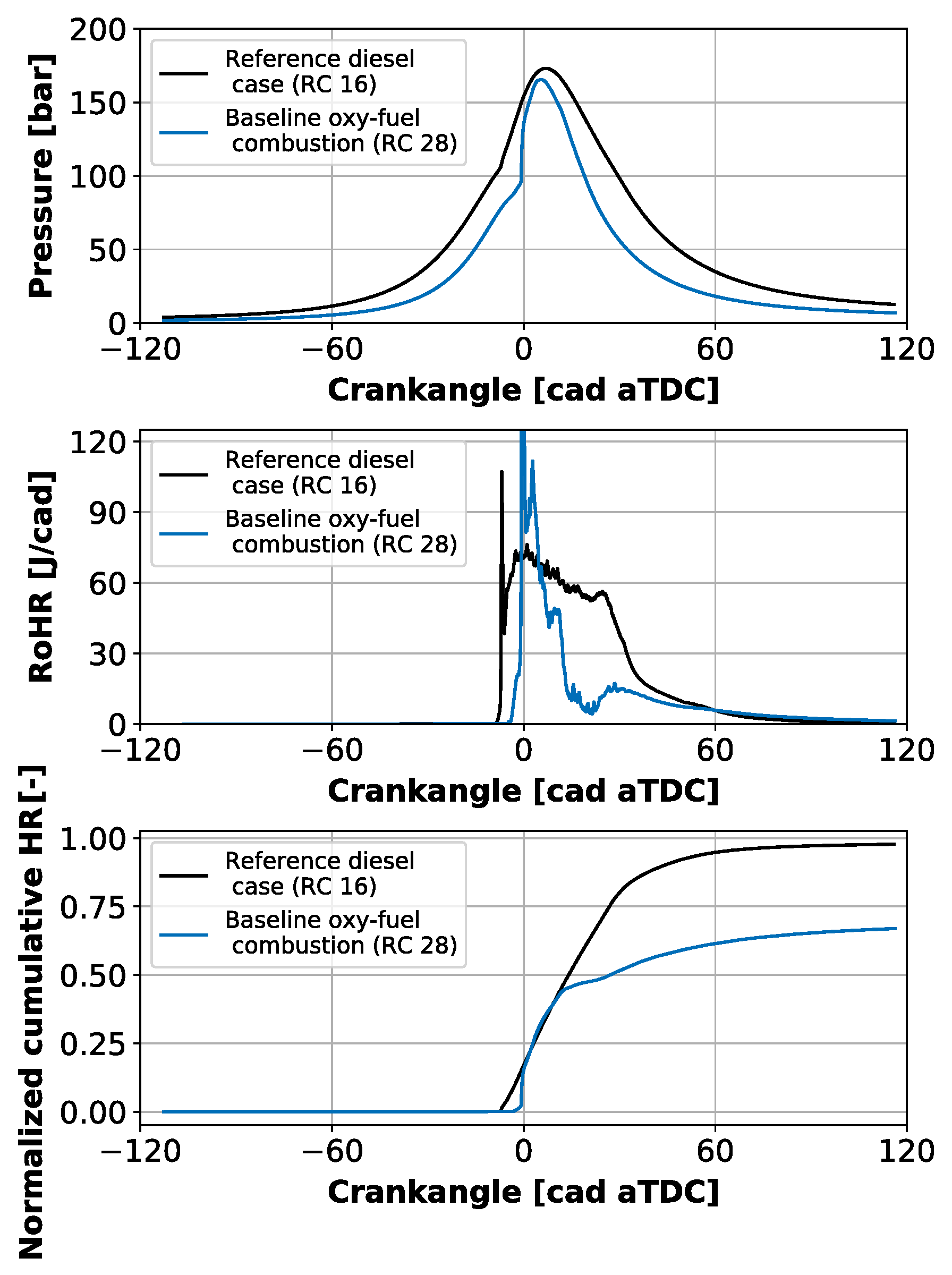
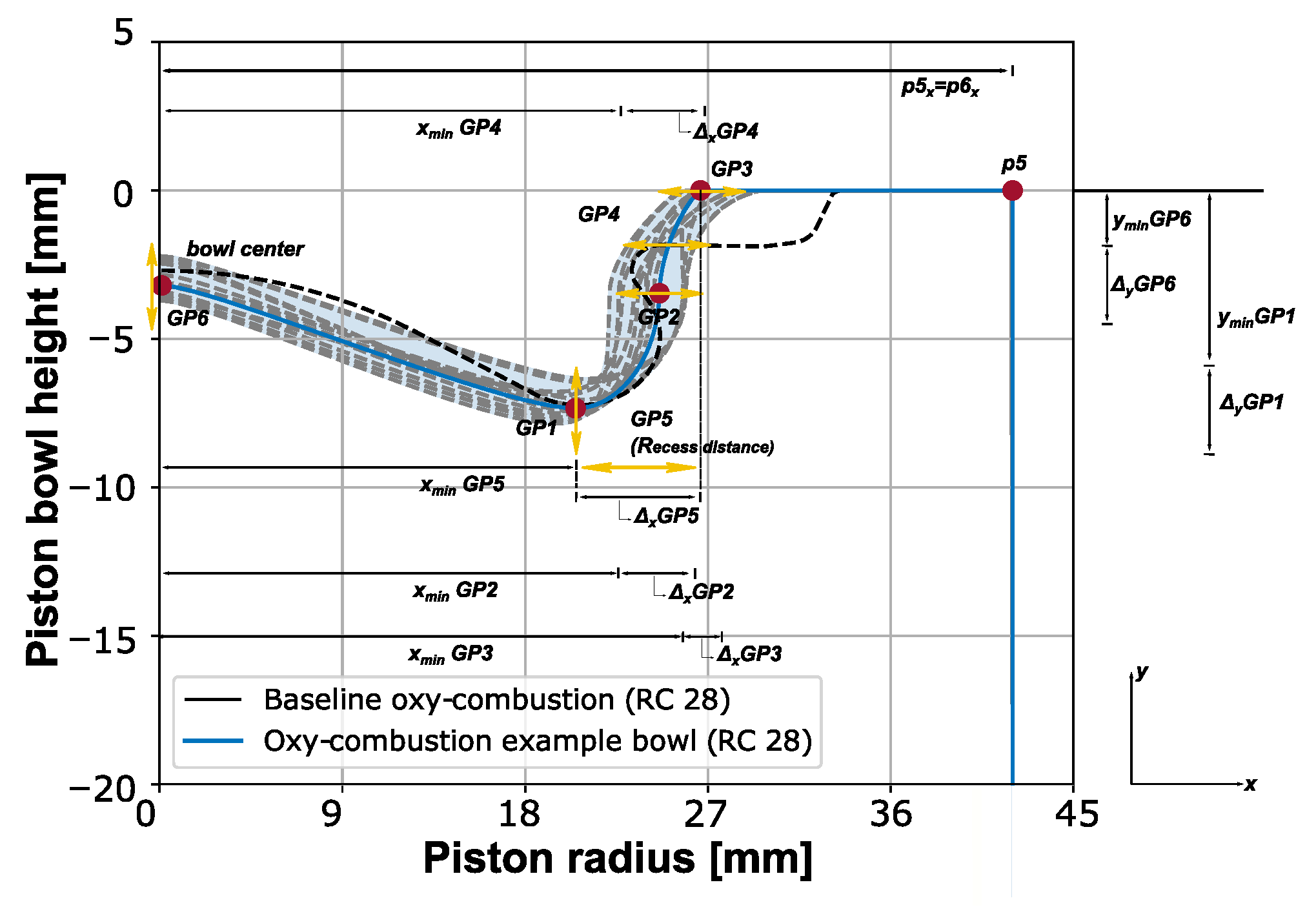
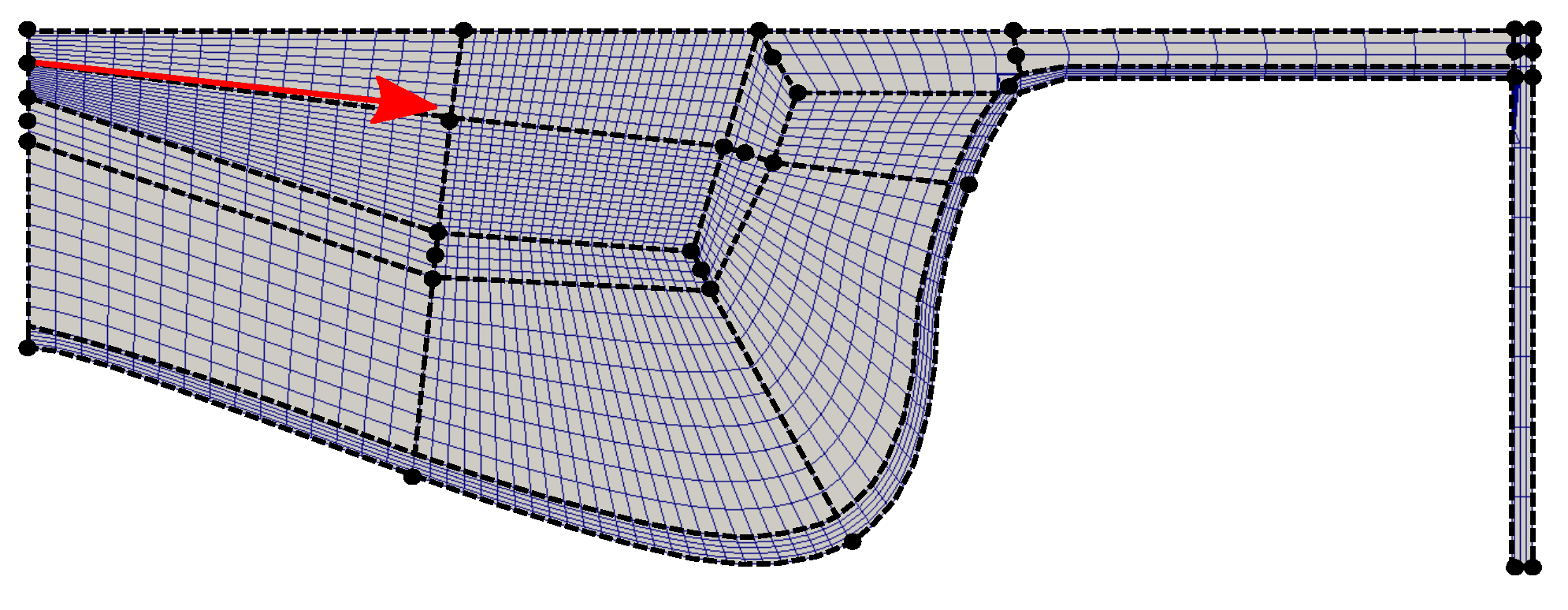
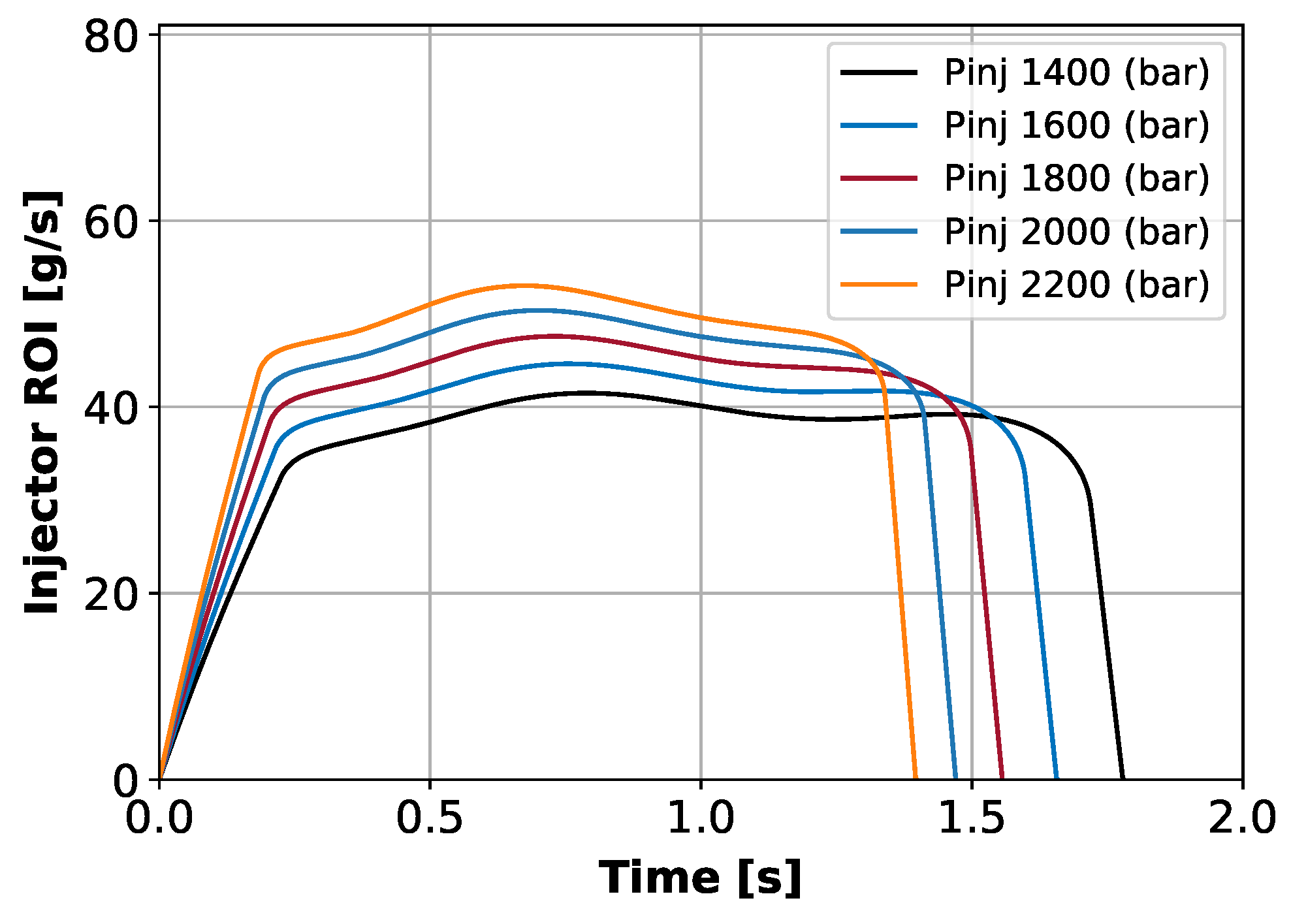
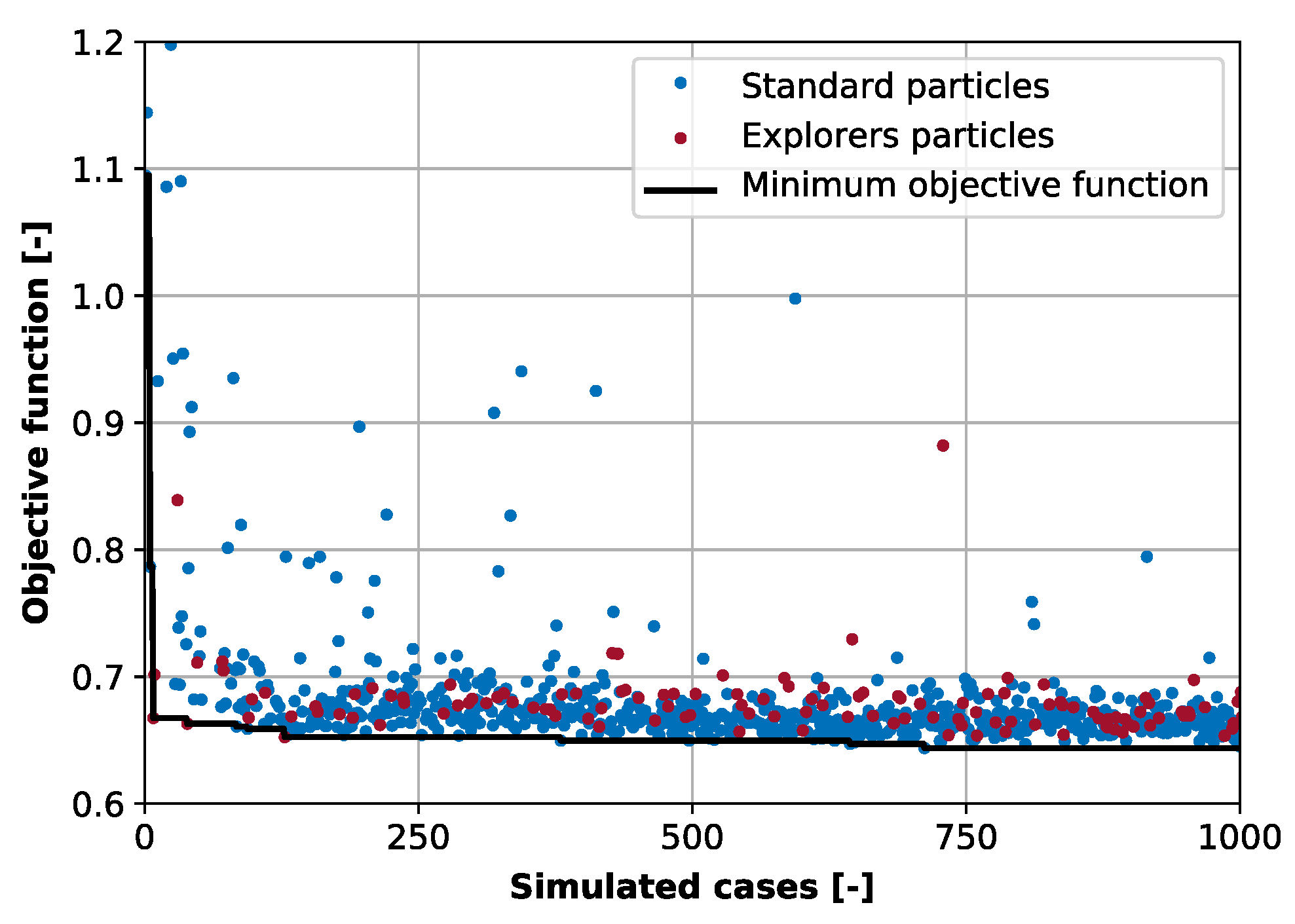
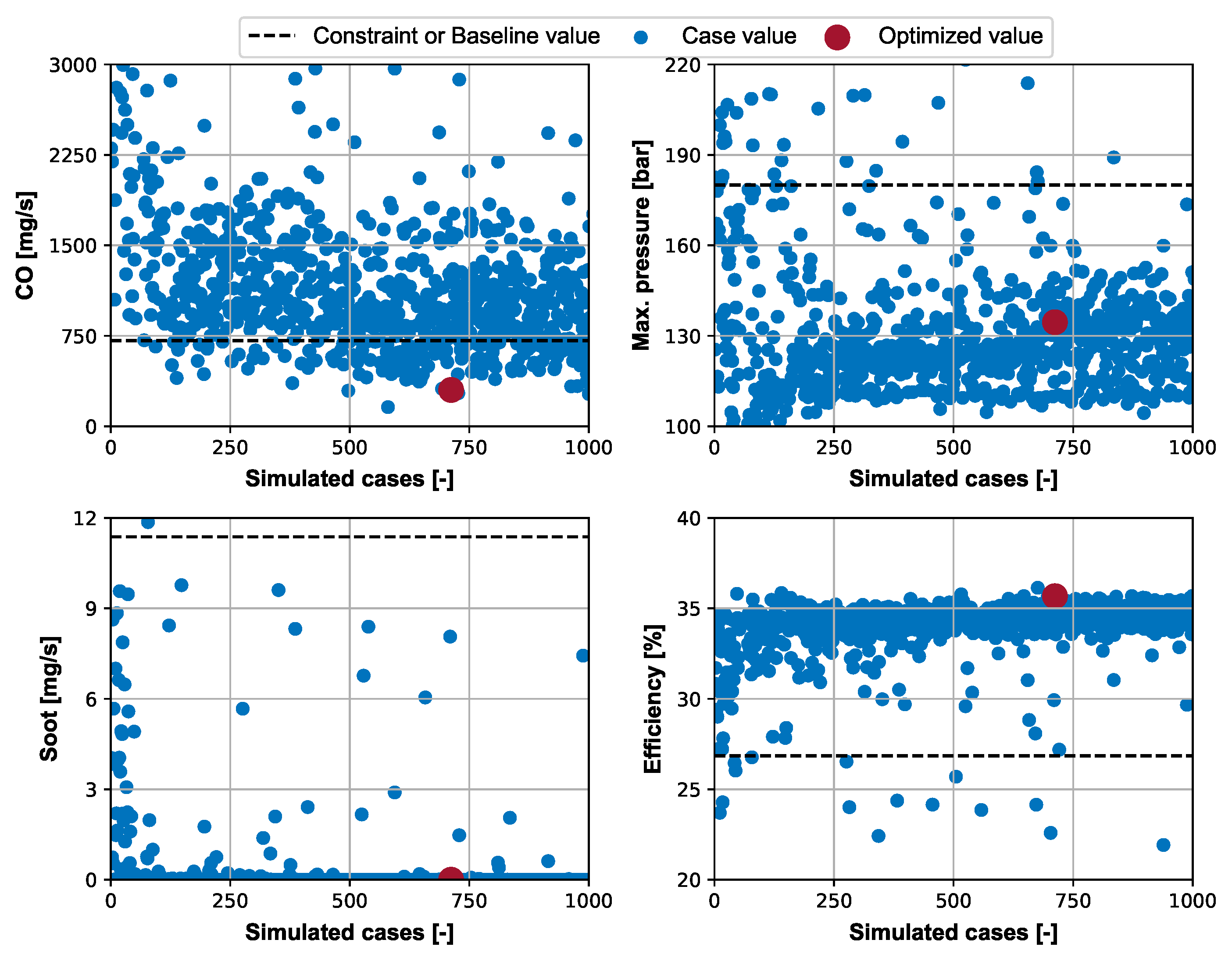

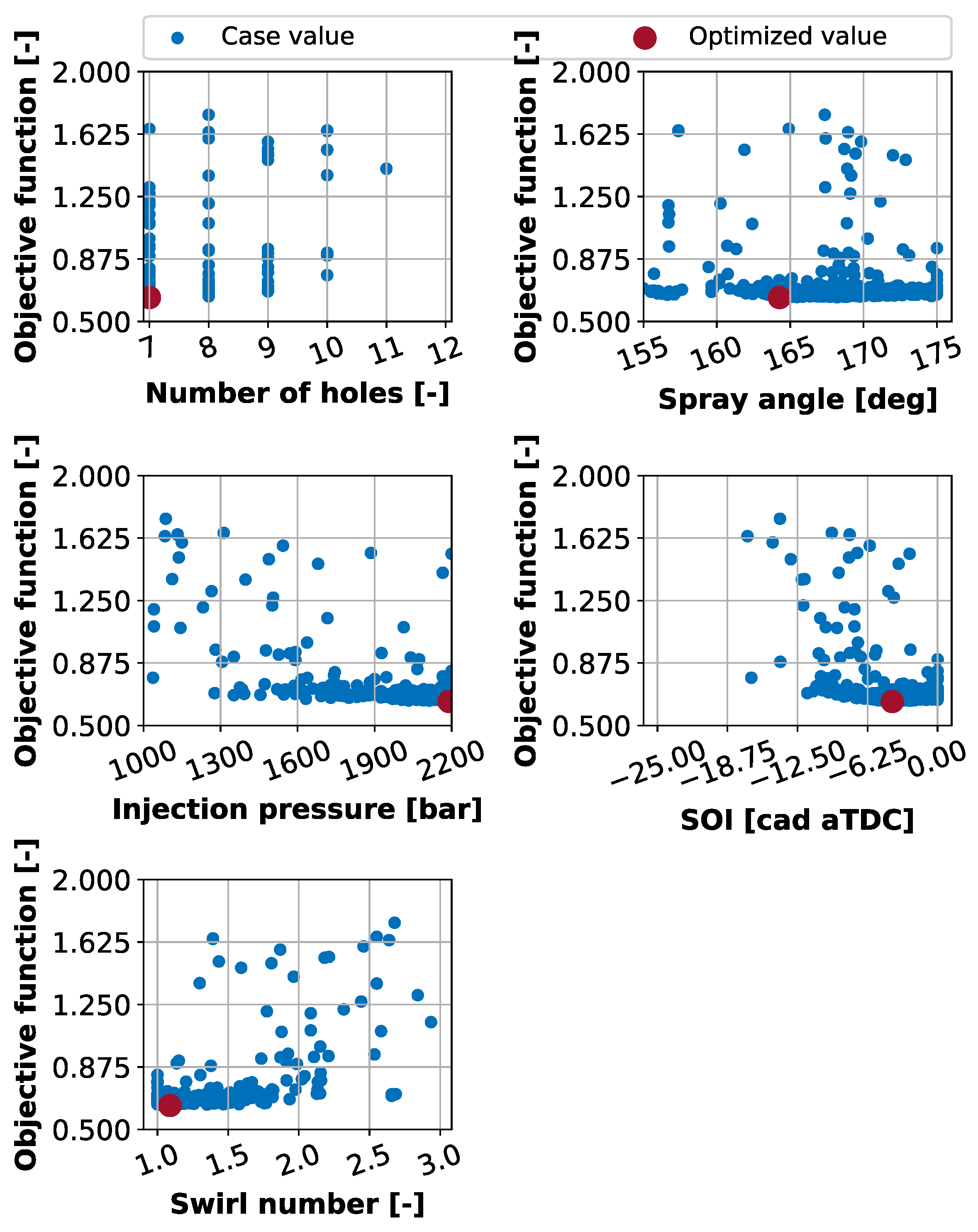


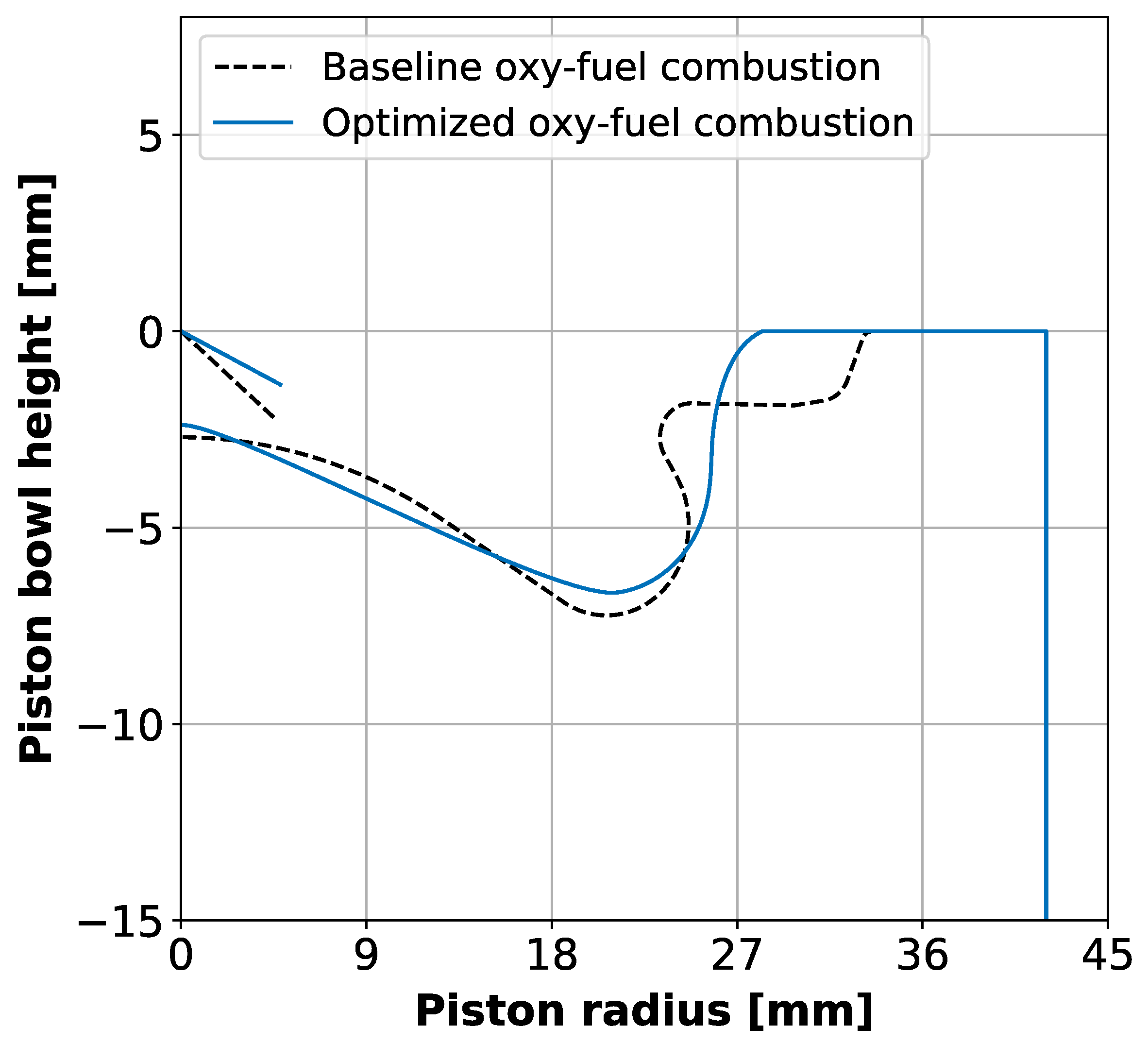
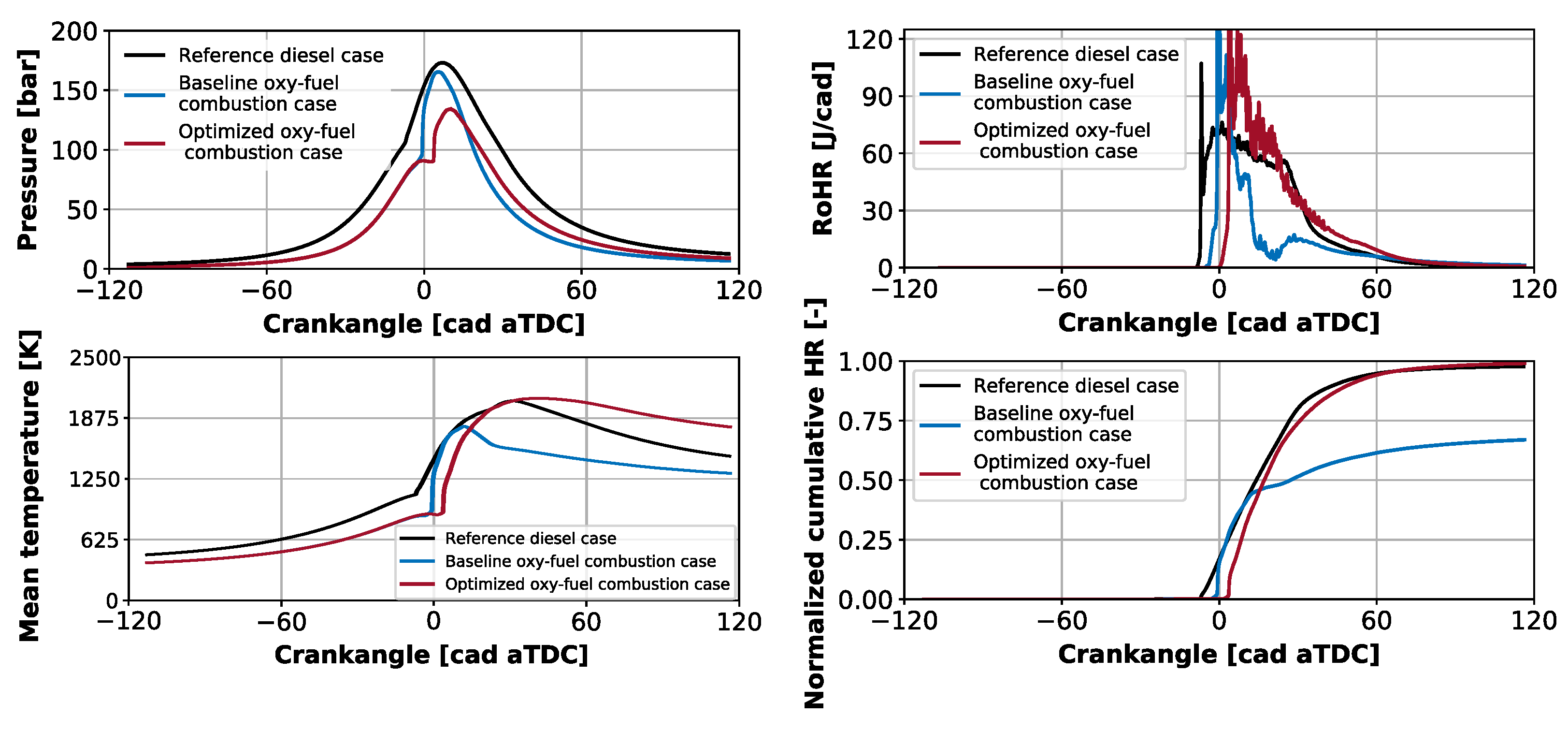
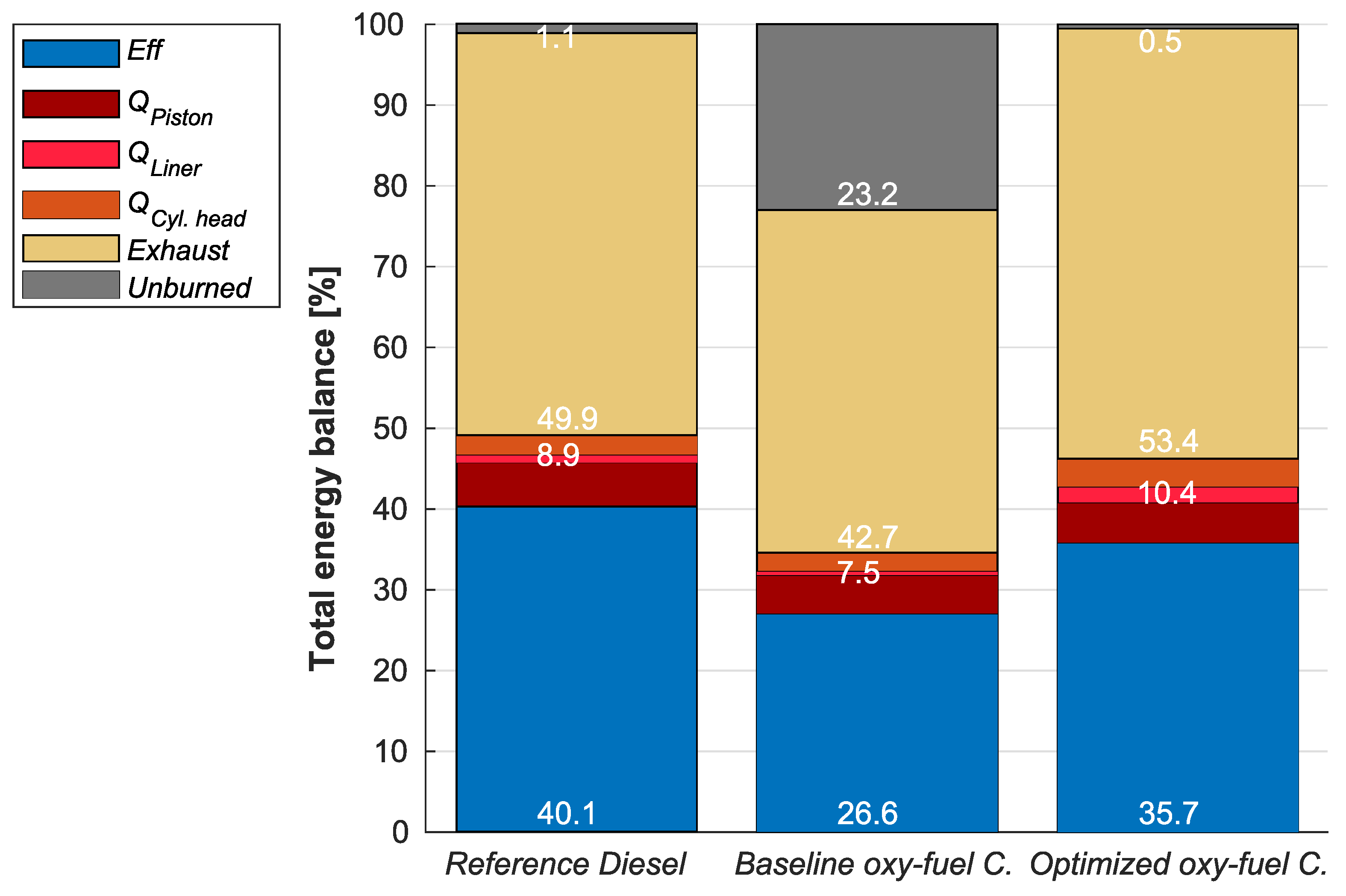
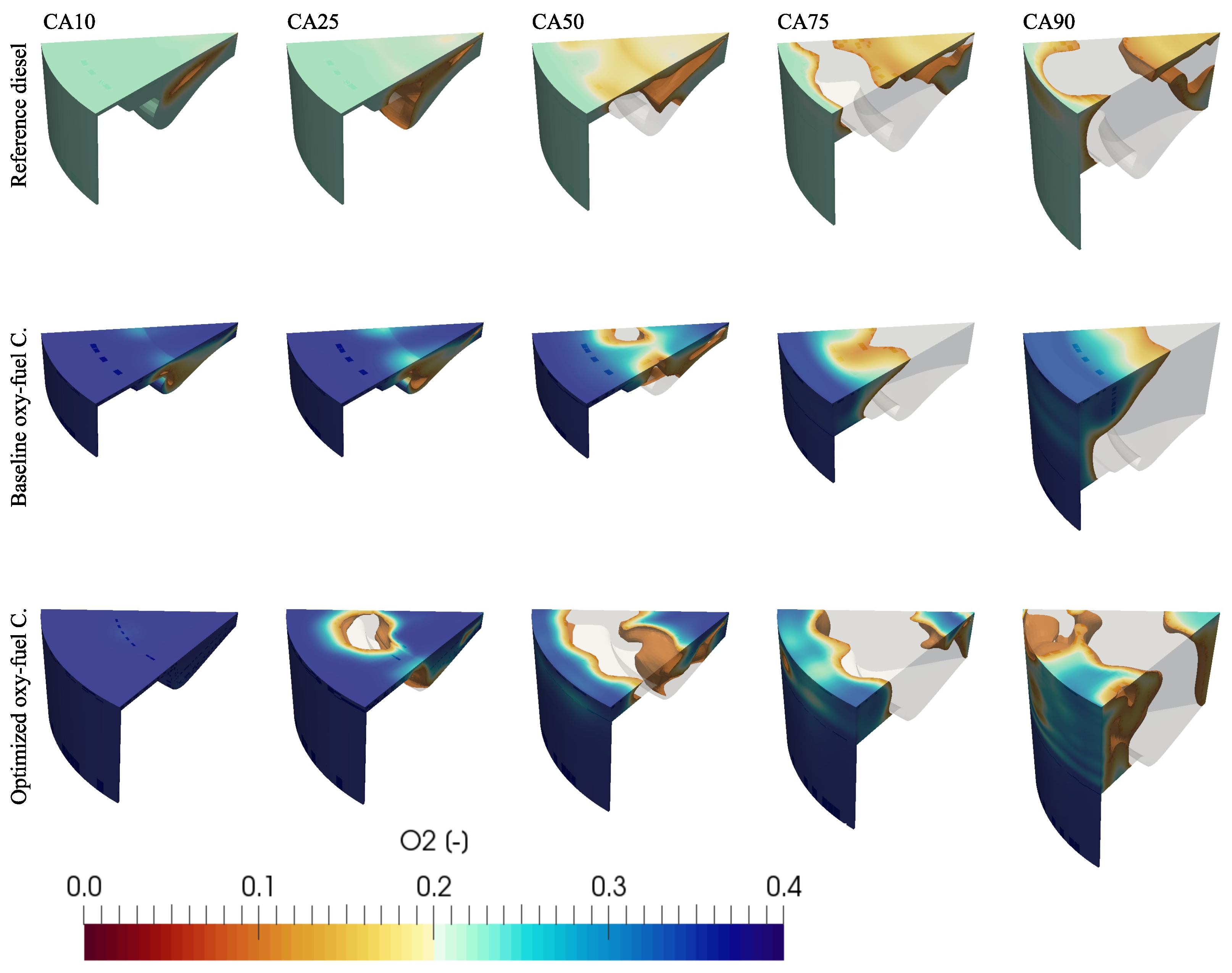
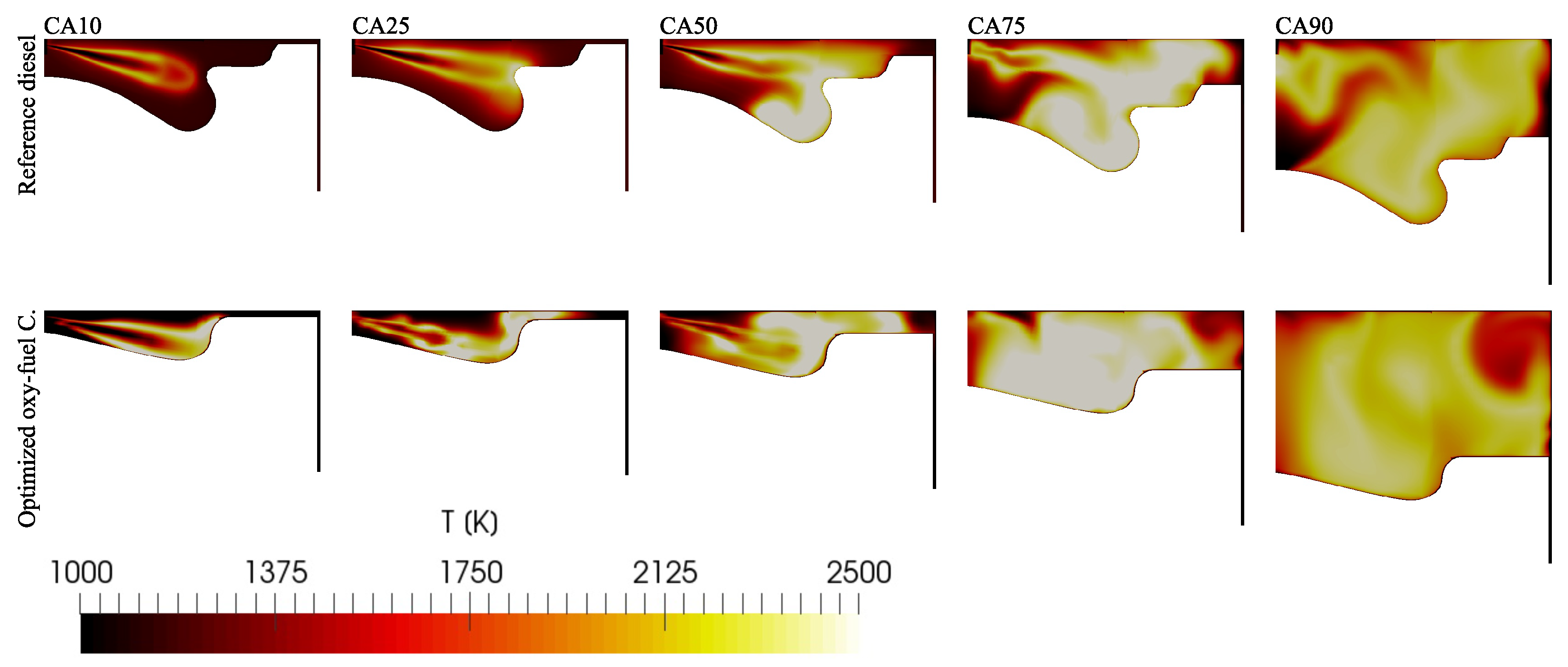
| Engine type | DI Diesel engine |
| Compression ratio [-] | 16:1 |
| Number of cylinders [-] | 4 |
| Bore/stroke [mm] | 85/96 |
| Volume [L] | 2.2 |
| Injector number of orifices | 10 |
| Spray angle [deg] | 154 |
| Injection | Blob Injector |
| Break-up | KH-RT |
| Collision | off |
| Evaporation | standard |
| Turbulence | RNG RANS |
| Wall Heat transfer | Angelberger |
| Combustion | RIF |
| Soot | Leung Lindstedt Jones |
| IVC [cad aTDC] | −112 |
| EVO [cad aTDC] | 116 |
| Pressure at IVC [bar] | 3.9 |
| Temperature at IVC [K] | 470 |
| Injection pressure [bar] | 1800 |
| Start Of Injection (SOI) [deg] | −11.5 |
| NO [ppm] | YSoot [-] | Gross Efficiency [%] | |
|---|---|---|---|
| Experimental data | 1253 | 4.18 × 10 | 44.8 |
| Fine mesh simulation | 1277 | 3.03 × 10 | 43.4 |
| Coarse mesh simulation | 1459 | 2.09 × 10 | 43.8 |
| Compression Ratio [-] | 28:1 |
| Engine speed [rpm] | 3500 |
| IMEP [bar] | 20.25 |
| Fuel mass [mg/cc] | 62 |
| Fuel LHV [MJ/kg] | 44.6 |
| SOI [deg] | −11.5 |
| Temperature at IVC [K] | 387 |
| Pressure at IVC [bar] | 1.83 |
| O [-] | 0.364 |
| HO [-] | 0.203 |
| CO [-] | 0.433 |
| EGR [%] | 70 |
| Parameter | Range |
|---|---|
| Geometrical parameter 1 [-] | [−0.5, 1.0] |
| Geometrical parameter 2 [-] | [−1.0, 1.25] |
| Geometrical parameter 3 [-] | [−1.0, 2.0] |
| Geometrical parameter 4 [-] | [0.0, 1.0] |
| Geometrical parameter 5 [-] | [−1.4, 0.1] |
| Geometrical parameter 6 [-] | [−0.5, 1.0] |
| Number of injector holes [-] | [7, 12] |
| Spray angle [] | [155, 175] |
| Swirl number at IVC [-] | [1.0, 3.0] |
| Injection pressure [bar] | [1000, 2200] |
| SOI [cad aTDC] | [−25, 0] |
| Condition | . . . . . Equation (7) |
| if < | |
| if ≥ | |
| Condition | . . . . . Equation (8) |
| if > | |
| if | |
| Condition | . . . . . Equation (9) |
| if < | |
| if | |
| Condition | . . . . . Equation (10) |
| if < | |
| if |
| Baseline Case | Oxy-Fuel Combust. Best Case | |
|---|---|---|
| Number of injector holes [-] | 10 | 7 |
| Spray angle [deg] | 154 | 164 |
| Swirl number [-] | 2.00 | 1.08 |
| Injection pressure [bar] | 1800 | 2190 |
| SOI [cad aTDC] | −11.5 | −4.04 |
| Reference Diesel | Baseline Oxy-Fuel C. | Optimized Oxy-Fuel C. | |
|---|---|---|---|
| Efficiency [%] | 40.1 | 26.6 | 35.7 |
| Soot [mg/s] | 0.35 | 11.4 | <0.0001 |
| CO [mg/s] | 177 | 1929 | 81 |
| HC [mg/s] | 28 | 206 | 4.5 |
Publisher’s Note: MDPI stays neutral with regard to jurisdictional claims in published maps and institutional affiliations. |
© 2022 by the authors. Licensee MDPI, Basel, Switzerland. This article is an open access article distributed under the terms and conditions of the Creative Commons Attribution (CC BY) license (https://creativecommons.org/licenses/by/4.0/).
Share and Cite
Serrano, J.R.; Bracho, G.; Gomez-Soriano, J.; Fernandes, C. Development of an Oxy-Fuel Combustion System in a Compression-Ignition Engine for Ultra-Low Emissions Powerplants Using CFD and Evolutionary Algorithms. Appl. Sci. 2022, 12, 7104. https://doi.org/10.3390/app12147104
Serrano JR, Bracho G, Gomez-Soriano J, Fernandes C. Development of an Oxy-Fuel Combustion System in a Compression-Ignition Engine for Ultra-Low Emissions Powerplants Using CFD and Evolutionary Algorithms. Applied Sciences. 2022; 12(14):7104. https://doi.org/10.3390/app12147104
Chicago/Turabian StyleSerrano, José Ramón, Gabriela Bracho, Josep Gomez-Soriano, and Cássio Fernandes. 2022. "Development of an Oxy-Fuel Combustion System in a Compression-Ignition Engine for Ultra-Low Emissions Powerplants Using CFD and Evolutionary Algorithms" Applied Sciences 12, no. 14: 7104. https://doi.org/10.3390/app12147104
APA StyleSerrano, J. R., Bracho, G., Gomez-Soriano, J., & Fernandes, C. (2022). Development of an Oxy-Fuel Combustion System in a Compression-Ignition Engine for Ultra-Low Emissions Powerplants Using CFD and Evolutionary Algorithms. Applied Sciences, 12(14), 7104. https://doi.org/10.3390/app12147104







